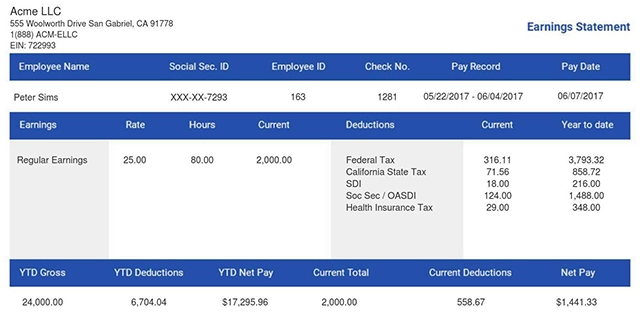What Is on a Pay Stub?
Pay stubs are important documents in any business setting. Nonetheless, many employers also approach them with a great deal of confusion. You need to familiarize yourself with the elements that appear on the pay stubs. This is important regardless of how long you have been running your business or hiring employees. You need to understand why they are essential so that you can keep detailed records of your employees’ pay. Here, you will get the answer to the question “What is on a pay stub?” and learn much more.
What Are Pay Stubs and Why Are They Important?
A pay stub is also called a pay slip or wages statement. It is a record of the amount paid to an employee over a certain period. For employers, it goes beyond the mere task of communicating the wages or salaries of their workers to them. They fulfill other important functions. They help to keep payroll records in check and follow taxation laws.
Employee pay stubs have also moved from simple receipts written manually. More improved forms are produced by modern computer technologies. Modern pay stubs should, therefore, contain all the information necessary. At the same time, this information must be well formatted in a way that can easily be understood.
What Are the Main Components of a Pay Stub?
To answer “What is on a pay stub?” let’s do a paycheck breakdown:
Employee and Company Information
All pay stubs have details that relate to the employer and employee. This section usually contains the personal information of both the employer and the employee. That includes the full name, address, and the last four digits of the employee’s SSN.
It should also indicate which period it covers and the date the pay was made. These schedules are relevant for extra hours and accrued benefits. It also assists both employers and their employees in monitoring payment progress over time. This avoids leaving any payment period unticked.
Gross Pay Components and Calculations
Gross pay refers to the total compensation package before deductions are made. For hourly employees, this part must reveal the straight-time working hours at the basic pay rate. It should also include overtime working hours at additional rates.
For the purpose of evaluating the gross pay for salaried employees, the process may seem relatively easier. However, certain aspects should not be neglected. There should be a breakdown of the salary scale for the year and the wages earned for the particular period. Any bonuses, commissions or other raises in compensation payable should also reflect. This helps avoid any ambiguous situations.
The pay stub must also include other related details, such as year-to-date calculations. This is helpful to the employers and employees, especially in monitoring total remuneration for the year. It is especially useful in the area of taxes and is used to ascertain that the annual tax forms, such as W-2, are correct.
Tax Withholdings and Obligations
The tax withholding section is a significant and challenging area of the pay stub. It is important for both companies and their employees. An employee’s federal income tax withholding must be clearly shown. This is based on their W-4 form and current IRS tables. These deductions may differ for individual employees, depending on their filing status and the allowances they have claimed.
Of all the taxes, employers need to pay extra attention to social security and Medicare taxes. Employers have to withhold 6.2% for Social Security, within the annual base limit. They have to withhold 1.45% for Medicare with an additional 0.9% for higher earners. Employers are also required to contribute by matching these contributions. However, this doesn’t include the additional Medicare tax. Employers must also disclose their matching contributions on the pay stub.
State and local taxes require withholding as well. However, withholding rates can vary by jurisdiction. Some states do not have income tax, while others have state and local taxes, which can be numerous. All these must be computed correctly and reflected. It is the duty of any employer to ensure that they get acquainted with the various tax requirements of their state. That includes the states and jurisdictions where they have employees.
Employee Benefits and Deductions
A popular question from employees is, “How do I understand my deductions on a pay stub?”. Apart from taxes, there are other deductions shown on the pay stub. These fall under various benefits that reduce the amount employees take home. Health insurance plans usually constitute one of the largest deductions. That includes medical, dental, and vision coverage. These amounts are deducted before tax, which alters the taxable wage.
Retirement contribution, which includes 401(k) or 403(b) plans, is another that has to be measured and shown properly. Such deductions may include the employees’ deductions and additional employer contributions. These deductions should be clearly elaborated on by the pay stub. That’s in terms of how they apply to the current payment period and the cumulative total for the year.
Other possible deductions include life insurance, disability insurance, and FSA contributions. Every amount to be deducted should be identified individually. The employer and employees should be able to check whether the necessary deductions have been made.
Net Pay and Year-to-Date Totals
The amount left after all the deductions and withholdings are taken is what is termed net pay or take-home pay. A final figure should be well presented on pay stubs. The structure of the pay stub should follow a sequence. This makes it easy for any person doing a paycheck breakdown to determine the net pay.
There are several important uses of year-to-date totals. It includes assisting the employee in monitoring their income for the particular year. The same goes for deductions. It also aids in tax computation and preparation, as well as the provision of details that may be needed in different monetary processes. For employers, these running totals are useful for keeping an accurate record of the calculation of wages. It saves time and effort in preparing audits and other reports at the end of the year.
Best Practices for Pay Stub Management
Now that you know what is on a pay stub, here are the best practices for employers:
-
Payroll Procedures
Employers should define the correct way of handling pay stubs by adopting the right procedures in payroll processing. They should review the information in the payroll records systematically. This may prevent the final consequences of mistakes of different amounts. Payroll personnel should be trained and educated frequently to be aware of the new rules and regulations. This helps employers avoid non-compliance.
-
Communication Channels
There should be a creation of proper communication channels. This is for tackling payroll inquiries or complaints. It promotes good relations with the employees and ensures proper satisfaction of complaints. Employers should also consider using quality payroll software or professional service providers. This comes in handy for both efficiency and compliance with the laws that are laid down.
-
Verification Process
It is not rare for many employers to implement a multi-step verification process in handling payroll. It may include, for example, comparing pay rate increases to documents delivered by the employees. They also confirm overtime rates. Lastly, they can check any benefit deduction changes before processing the payroll. Payroll account reconciliation is good practice. It brings out whether or not all the payments and deductions are properly made and acknowledged.
Final Thoughts
Pay stubs have often been viewed as simply receipts of payment. However, they are important documents that accrue various benefits to employers and employees. Knowing what is on a pay stub ensures you have accurate information. With this paycheck breakdown, employers can approach this aspect of payroll properly and legally. They can also keep abreast of regulatory changes to guarantee good relationships with employees.
Creating accurate and detailed pay stubs is essential for maintaining compliance, transparency, and good relationships with your employees. Take the guesswork out of pay stub management and ensure precision with our pay stub generator. You get a user-friendly platform that simplifies the process. In minutes, you can streamline your payroll process and focus on what truly matters—taking control of your business operations.














